Roxio Toast 11 Titanium Operation Manual

User Guide

ii |
Roxio Toast 11 User Guide |
www.roxio.com |
Legal Information
Copyright © 1994-2011 Sonic Solutions. All rights reserved. Use of this product is subject to your agreement to all of the terms of each of the license agreements included in this package. This product may be protected by one or more US and/or foreign patents, including certain patents that may be listed at www.sonic.com/innovation/patents.
Trademarks
Roxio, Toast, the toaster with discs icon, DivX, DivX Plus, the DivX Plus logo, and Sonic Solutions are trademarks or registered trademarks owned by Sonic Solutions in the United States and other jurisdictions.
Third-Party Trademarks and Technologies
Mac, the Mac logo, QuickTime, Aperture, iLife, iDVD, iPhoto, iMovie, iTunes, DVD Studio Pro, Final Cut, iPod, iPhone, iPad and Apple TV are trademarks of Apple, Inc. in the U.S. and other countries.
PowerPC is a registered trademark of International Business Machines Corporation.
Intel is a registered trademark of Intel Corporation in the U.S. and/or other countries.
Adobe, Flash and Lightroom are either trademarks or registered trademarks of Adobe Systems Incorporated in the United States and/or other countries.
Turbo.264, Turbo.264 HD, EyeTV, and the EyeTV logo are registered trademarks of Elgato Systems.
TiVo, TiVoToGo, and the TiVo logo are trademarks or registered trademarks of TiVo Inc. or its subsidiaries.
AVCHD and the AVCHD logo and AVCHD Lite are trademarks of Panasonic Corporation and Sony Corporation and are used under license.
Blu-ray and the Blu-ray Disc logo are trademarks of the Blu-ray Disc Association.
YouTube and the YouTube logo are trademarks of Google, Inc.
Vimeo and the Vimeo logo are trademarks of Vimeo, LLC.
Facebook is a registered trademark of Facebook, Inc.

Roxio Toast 11 User Guide |
iii |
Legal Information |
NVIDIA, CUDA, and the CUDA logo are trademarks or registered trademarks of NVIDIA Corporation.
The RIM and BlackBerry families of related marks, images, and symbols are the exclusive properties of and trademarks of Research in Motion Limited – used by permission.
Palm and Treo are among the trademarks or registered trademarks owned by or licensed to Palm, Inc.
CD and music-related data from Gracenote, Inc., copyright © 2000 to present Gracenote. Gracenote Software, copyright © 2000 to present Gracenote. One or more patents owned by Gracenote apply to this product and service. See the Gracenote website for a non-exhaustive list of applicable Gracenote patents. Gracenote, CDDB, MusicID, the Gracenote logo and logotype, and the “Powered by Gracenote” logo are either registered trademarks or trademarks of Gracenote in the United States and/or other countries.
Music recognition technology and related data are provided by Gracenote®. Gracenote is the industry standard in music recognition technology and related content delivery. For more information, please visit www.gracenote.com.
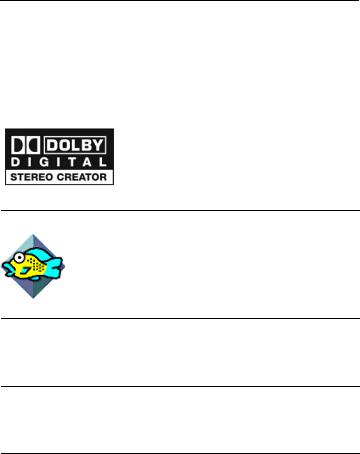
iv |
Roxio Toast 11 User Guide |
www.roxio.com |
“Dolby” and the double-D symbol are trademarks of Dolby laboratories.
This product contains one or more programs protected under international and U.S. copyright laws as unpublished works. They are confidential and proprietary to Dolby Laboratories. Their reproduction or disclosure, in whole or in part, or the production of derivative works therefrom without the express permission of Dolby Laboratories is prohibited. Copyright 1992-1997 by Dolby Laboratories, Inc. All rights reserved.
Manufactured under license from Dolby Laboratories.
Ogg Vorbis audio compression technology provided courtesy of the Xiph.Org Foundation.
XiphQT - Copyright © 2005, 2006, 2007 Arek Korbik
This product uses Xiph QuickTime Components under the GNU Lesser General Public License v2.1. A copy of this license and source code can be found inside the application bundle. More information is available at http://www.xiph.org/quicktime.
FFmpeg is a trademark of Fabrice Bellard, originator of the FFMPEG project.
This product uses libavcodec, part of FFmpeg, under the GNU Lesser General Public License v2.1. A copy of the license and source code can be found inside the application bundle. More information is available at http://ffmpeg.org.
libvorbis and libogg
Copyright (c) 1994-2004 Xiph.org Foundation
THIS SOFTWARE IS PROVIDED BY THE COPYRIGHT HOLDERS AND CONTRIBUTORS ``AS IS'' AND ANY EXPRESS OR IMPLIED WARRANTIES, INCLUDING, BUT NOT LIMITED TO, THE IMPLIED WARRANTIES OF MERCHANTABILITY AND FITNESS FOR A PARTICULAR PURPOSE ARE DISCLAIMED. IN NO EVENT SHALL THE REGENTS OR CONTRIBUTORS BE LIABLE FOR ANY DIRECT, INDIRECT, INCIDENTAL, SPECIAL, EXEMPLARY, OR CONSEQUENTIAL DAMAGES (INCLUDING, BUT NOT LIMITED TO, PROCUREMENT OF SUBSTITUTE GOODS OR SERVICES; LOSS OF USE, DATA, OR PROFITS; OR BUSINESS INTERRUPTION) HOWEVER CAUSED AND ON ANY THEORY OF LIABILITY, WHETHER IN CONTRACT, STRICT LIABILITY, OR TORT (INCLUDING NEGLIGENCE OR OTHERWISE) ARISING IN ANY WAY OUT OF THE USE OF THIS SOFTWARE, EVEN IF ADVISED OF THE POSSIBILITY OF SUCH DAMAGE.
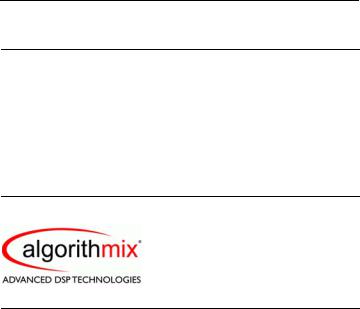
Roxio Toast 11 User Guide |
v |
Legal Information |
libflac and libflac++
Copyright (C) 2000, 2001, 2002, 2003, 2004 Josh Coalson
THIS SOFTWARE IS PROVIDED BY THE COPYRIGHT HOLDERS AND CONTRIBUTORS ``AS IS'' AND ANY EXPRESS OR IMPLIED WARRANTIES, INCLUDING, BUT NOT LIMITED TO, THE IMPLIED WARRANTIES OF MERCHANTABILITY AND FITNESS FOR A PARTICULAR PURPOSE ARE DISCLAIMED. IN NO EVENT SHALL THE FOUNDATION OR CONTRIBUTORS BE LIABLE FOR ANY DIRECT, INDIRECT, INCIDENTAL, SPECIAL, EXEMPLARY, OR CONSEQUENTIAL DAMAGES (INCLUDING, BUT NOT LIMITED TO, PROCUREMENT OF SUBSTITUTE GOODS OR SERVICES; LOSS OF USE, DATA, OR PROFITS; OR BUSINESS INTERRUPTION) HOWEVER CAUSED AND ON ANY THEORY OF LIABILITY, WHETHER IN CONTRACT, STRICT LIABILITY, OR TORT (INCLUDING NEGLIGENCE OR OTHERWISE) ARISING IN ANY WAY OUT OF THE USE OF THIS SOFTWARE, EVEN IF ADVISED OF THE POSSIBILITY OF SUCH DAMAGE.
Audio effect engine licensed by Algorithmix, www.algorithmix.com.
VST is a trademark of Steinberg Media Technologies GmbH.
CD and music-related data from Gracenote, Inc., copyright © 2000-2008 Gracenote. Gracenote Software, copyright © 2000-2008 Gracenote. One or more patents owned by Gracenote apply to this product and service. See the Gracenote website for a non-exhaustive list of applicable Gracenote patents. Gracenote, CDDB, MusicID, the Gracenote logo and logotype, and the “Powered by Gracenote” logo are either registered trademarks or trademarks of Gracenote in the United States and/or other countries.
Music recognition technology and related data are provided by Gracenote®. Gracenote is the industry standard in music recognition technology and related content delivery. For more information, please visit www.gracenote.com.

vi |
Roxio Toast 11 User Guide |
www.roxio.com |
Changes
The material in this document is for information only and is subject to change without notice. While reasonable efforts have been made in the preparation of this document to assure its accuracy, Sonic Solutions assumes no liability resulting from errors or omissions in this document, or from the use of the information contained herein.
Sonic Solutions reserves the right to make changes in the product design without reservation and without notification to its users.
Disclaimer
THIS PRODUCT DOES NOT BYPASS OR CIRCUMVENT COPY PROTECTION. THIS PRODUCT DOES NOT ENABLE YOU TO COPY DVDS CONTAINING CSS-ENCRYPTION OR OTHER COPY-PROTECTED CONTENT. IF THIS PRODUCT ALLOWS YOU TO COPY ANY CONTENT, YOU MAY DO SO ONLY IF YOU OWN THE COPYRIGHT, YOU HAVE OBTAINED PERMISSION TO COPY FROM THE COPYRIGHT OWNER, OR YOU HAVE THE LEGAL RIGHT TO MAKE SUCH A COPY. IF YOU ARE NOT THE COPYRIGHT OWNER OR YOU HAVE NOT OBTAINED PERMISSION TO COPY FROM THE COPYRIGHT OWNER, YOU MAY BE VIOLATING COPYRIGHT AND OTHER LAWS LAW AND YOU MAY BE SUBJECT TO CLAIMS FOR DAMAGES AND/OR CRIMINAL PENALTIES. ANY ILLEGAL USE OF THIS PRODUCT IS STRICTLY PROHIBITED. IF YOU ARE UNCERTAIN ABOUT YOUR RIGHTS, YOU SHOULD CONTACT YOUR LEGAL ADVISOR. YOU ASSUME FULL RESPONSIBILITY FOR THE LEGAL AND RESPONSIBLE USE OF THIS PRODUCT.

vii
Contents
1 Getting Started with Toast 11
Introduction . . . . . . . . . . . . . . . . . . . . . . . . . . . 12 Installing The Software . . . . . . . . . . . . . . . . . . . 13 Getting Started with Toast. . . . . . . . . . . . . . . . 15 The Toast Main Window. . . . . . . . . . . . . . . . . . 17 Burning Your First Disc With Toast . . . . . . . . . . 19 Converting Video. . . . . . . . . . . . . . . . . . . . . . . 20 Choosing the Right Project . . . . . . . . . . . . . . . 23 About Discs . . . . . . . . . . . . . . . . . . . . . . . . . . . . 24 Using the Media Browser . . . . . . . . . . . . . . . . . 26 Changing Recorder Settings . . . . . . . . . . . . . 28 Saving and Opening Toast Projects. . . . . . . . 30 Erasing Discs . . . . . . . . . . . . . . . . . . . . . . . . . . . 31 Ejecting a Disc . . . . . . . . . . . . . . . . . . . . . . . . . 31 Toast Extras . . . . . . . . . . . . . . . . . . . . . . . . . . . . 32 Technical Support Options . . . . . . . . . . . . . . . 33

viii |
Roxio Toast 11 User Guide |
www.roxio.com |
|
|
|
2 Using Other Toast Features 35
Viewing Information about a Disc . . . . . . . . 36 Saving Disc Images. . . . . . . . . . . . . . . . . . . . . 36 Mounting Disc Images . . . . . . . . . . . . . . . . . . 37 Comparing Files or Folders . . . . . . . . . . . . . . . 38 Creating a Temporary Partition. . . . . . . . . . . 39
Making Data Discs 41 |
|
3 What is a Data Disc? . . . . . . . . . . . . . . . . . . . |
42 |
Types of Data Discs . . . . . . . . . . . . . . . . . . . . . |
42 |
Overview of Making a Data Disc . . . . . . . . . |
44 |
Burning Projects to Multiple Recorders . . . . . |
45 |
Making a Mac Only Disc . . . . . . . . . . . . . . . . |
47 |
Making a Mac & PC Disc . . . . . . . . . . . . . . . . |
53 |
Making a DVD-ROM Disc . . . . . . . . . . . . . . . . |
58 |
Making a Custom Hybrid Disc . . . . . . . . . . . . |
59 |
Making a Mac Volume Disc . . . . . . . . . . . . . |
61 |
Making a Photo Disc. . . . . . . . . . . . . . . . . . . . |
63 |
Using Toast Dynamic Writing . . . . . . . . . . . . . |
65 |
Making Audio Discs 67 |
|
4 What is an Audio Disc?. . . . . . . . . . . . . . . . . . |
68 |
Types of Audio Discs . . . . . . . . . . . . . . . . . . . . |
68 |
Overview of Making an Audio Disc . . . . . . . |
69 |

Roxio Toast 11 Getting Started Guide |
ix |
Contents |
Making an Audio CD . . . . . . . . . . . . . . . . . . . 70
Making a Music DVD . . . . . . . . . . . . . . . . . . . 75
Making an MP3 Disc . . . . . . . . . . . . . . . . . . . . 80
Making an Enhanced Audio CD. . . . . . . . . . 81
Making a Mixed Mode CD . . . . . . . . . . . . . . 82
Making Video Discs 83 |
|
5 What is a Video Disc?. . . . . . . . . . . . . . . . . . |
. 84 |
Types of Video Discs . . . . . . . . . . . . . . . . . . . . |
84 |
Overview of Making a Video Disc . . . . . . . . |
85 |
Making a DVD or BD Video Disc . . . . . . . . . . |
87 |
Using Plug & Burn. . . . . . . . . . . . . . . . . . . . . . . |
95 |
Making a DVD From VIDEO_TS Folders . . . . |
106 |
Making a VIDEO_TS Compilation . . . . . . . . |
110 |
Making a BDMV Folder Disc. . . . . . . . . . . . . |
111 |
Creating an AVCHD Archive. . . . . . . . . . . . |
112 |
Making a Video CD or Super Video CD. . . |
113 |
Editing Video . . . . . . . . . . . . . . . . . . . . . . . . . |
115 |
Copying Discs 117 |
|
6 Types of Copies . . . . . . . . . . . . . . . . . . . . . . . |
118 |
Overview of Making a Copy . . . . . . . . . . . . |
118 |
Copying a Disc . . . . . . . . . . . . . . . . . . . . . . . |
119 |
Copying a Disc Image File. . . . . . . . . . . . . . |
121 |
Merging Disc Images . . . . . . . . . . . . . . . . . . |
122 |

x |
Roxio Toast 11 User Guide |
www.roxio.com |
|
|
|
Converting Media 123 |
|
7 Why convert audio and video? . . . . . . . . . |
124 |
Converting DVD-Video Content . . . . . . . . . |
125 |
Changing Copy Options . . . . . . . . . . . . . . . |
126 |
Converting Video Files . . . . . . . . . . . . . . . . . |
127 |
Creating Custom Profiles . . . . . . . . . . . . . . . |
130 |
VideoBoost. . . . . . . . . . . . . . . . . . . . . . . . . . . |
132 |
Pause and Resume Video Conversion. . . . |
133 |
Converting Audio Files . . . . . . . . . . . . . . . . . |
134 |
Converting Audiobooks . . . . . . . . . . . . . . . . |
135 |

11
Getting Started with Toast
In this chapter
Introduction |
12 |
Installing The Software |
13 |
The Toast Main Window |
17 |
Burning Your First Disc With Toast |
19 |
Converting Video |
20 |
Choosing the Right Project |
23 |
Using the Media Browser |
26 |
Changing Recorder Settings |
28 |
Saving and Opening Toast Projects |
30 |
Erasing Discs |
31 |
Ejecting a Disc |
31 |
Toast Extras |
32 |
Technical Support Options |
33 |
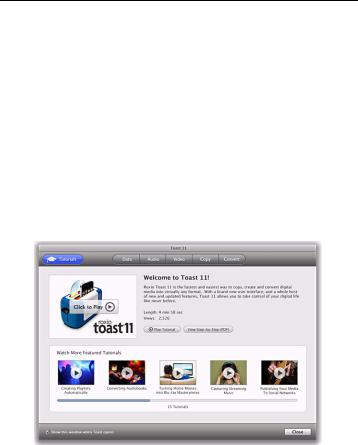
12Roxio Toast 11 User Guide www.roxio.com
Introduction
Toast® 11 Titanium brings you award winning disc burning, video conversion and a whole lot more. Everything you need to burn, watch, listen to, and share your digital life is right at your fingertips.
This guide will help you get started using Toast. The features and capabilities described are available in the full Toast Titanium product. Your version may not have all these features and capabilities if it came bundled with a disc recorder or other hardware device. The software includes appropriate messages if you have the limited version.
To register your software, choose Help > Product Registration.
For additional information, choose Help > Product Support.
The Toast Assistant. Use it to start a project or watch a tutorial.
Getting Started with Toast |
13 |
||
Installing The Software |
|||
|
|||
|
|
|
|
Installing The Software
To use Toast you will need the following hardware and software:
■Mac® computer with an Intel® processor and 1GB of RAM
■Mac OS® X 10.5 or 10.6
■Approximately 1GB free disk space to install all components
■VideoBoost requires a compatible NVIDIA® graphics card and 4 GB of RAM for optimal performance. (A list of compatible cards can be found at www.roxio.com/toast.)
■DVD drive required for installation
■Internet connection required for video tutorials, product updates, and other functionality
The latest versions of iTunes, iPhoto and iMovie are recommended.
To install the software:
1Insert the installation DVD into your drive (or if purchased online and downloaded, double-click on the downloaded .DMG file).
The Roxio Toast window appears on your desktop.
2Double-click the Toast 11 Titanium installer.
3Follow the instructions on screen to complete the installation.
4In the applications folder on your hard disk, browse to the Toast 11 Titanium folder. You will see an icon for Toast 11 Titanium along with other optional components you've installed.
5Double-click the Toast Titanium icon and follow the on-screen instructions to set up Toast for the first time.

14Roxio Toast 11 User Guide www.roxio.com
Additional Software Installed
The Toast 11 folder also contains the following software if you’ve selected to install it:
■SDX audio capture software
■Disc Cover 3 RE labeling software
■GetBackup Pro RE backup software
■DiscCatalogMaker RE disc cataloging software
■TiVoToGo for the Mac
For more information, see Toast Extras on page 32.
Getting Started with Toast |
15 |
||
Getting Started with Toast |
|||
|
|||
|
|
|
|
Getting Started with Toast
When Toast is launched for the first time, Toast Assistant opens. Use it to select a project or watch a tutorial.
To get started:
1Select one of the project categories:
■Data: Put any file or folder on a disc for archiving or backup purposes. For use in a Mac, PC, or other computer. See Making Data Discs on page 41 or Making a Photo Disc on page 63.
■Audio: Make an audio CD, music DVD, or MP3 disc for use in a computer, home or car stereo, or set-top DVD player. See Making Audio Discs on page 67.
■Video: Make VCDs, SVCDs, DVD-Video discs, Blu-ray or High-Def DVDs for use in a computer or set top player. Blu-ray video and High-Definition DVD projects require installation of the Toast 11 HD/BD Plug-in (available separately). See Making Video Discs on page 83.
■Copy: Copy discs, including CDs, DVDs, and Blu-ray discs, or disc image files. See Copying Discs on page 117.
■Convert: Convert DVD-Video discs and folders, or audio and video files to other formats or for use on portable devices. Publish directly to online sharing services. See Converting Media on page 123.
2A list of available formats appears. To see more choices, click on the drop-down menu at the top-right corner of the window and select View Advanced Projects.
3Double-click the desired format. Toast’s main window opens with the correct format selected.
You can disable the Assistant for future launches by disabling the Show this window when Toast opens option at the bottom left corner of the window.
When working in Toast, you can always get back to the Assistant by selecting New From Assistant on the File menu.

16Roxio Toast 11 User Guide www.roxio.com
Tutorials
Click Tutorials to see a list of video tutorials currently available for Toast. The Introduction to Toast 11 tutorial is included as part of the application itself; an Internet connection is required to view the other tutorials.
Getting Started with Toast |
17 |
||
The Toast Main Window |
|||
|
|||
|
|
|
|
The Toast Main Window
The Toast main window contains the following components:
Project Categories
As with the Toast Assistant, the various project categories are laid out across the top of the screen.
Content Area
This is the main area at the left side of the window. For most project types, this is where you drag your files to add them to a project.
Options Area
Located at the right side of the screen, the options area allows you to select options for the current project. This area may be hidden if the Media Browser is being shown. To reveal the options area, simply click on the Options button at the top right of the window.
Space Indicator
Located across the bottom of the Toast window, the space indicator displays exactly how much content you've added to the current project. You can choose CD, DVD or Blu-ray media types to have the indicator calibrated for your target disc.
Record Button
Located at the bottom right of the Toast window, the red record button will begin recording your disc. For video conversion projects, this will also begin exporting your video. The name and function of the button can vary by project. For example, in the Convert category it acts as a Convert button to begin exporting your audio or video.
Media Browser
The Media Browser allows you to easily browse or find music, photos, video, or other files, and preview or add them to a Toast project. On first launch this window will be hidden. To bring up the Media Browser, click the Media button at the top of the Options area. This will hide the options and reveal the Media Browser.
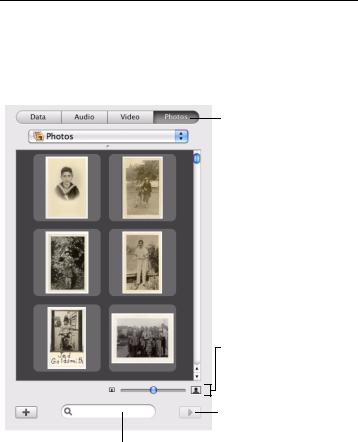
18Roxio Toast 11 User Guide www.roxio.com
The Media Browser can also be separated from the Toast main window by clicking the icon to the right of the Media button. This allows you to use the Media Browser while the Options area is visible.
Media Type
Buttons
Thumbnail size controls
Preview Button
|
|
Filter or |
Add Button |
||
|
|
Search Box |

Getting Started with Toast |
19 |
||
Burning Your First Disc With Toast |
|||
|
|||
|
|
|
|
Burning Your First Disc With Toast
This section describes the basic process of burning any disc with Toast’s main window.
To make a disc with Toast:
1Select the project category. From the Assistant or the main Toast window, select a project category.
■Data — Put any file or folder on a disc for archiving or backup purposes, for use in a Mac, PC, or any computer. See Making Data Discs on page 41.
■Audio — Make an audio CD, music DVD or MP3 disc for use in a computer, home or car stereo, or set-top DVD player. See Making Audio Discs on page 67.
■Video — Make VCDs, SVCDs, DVD-Video discs, Blu-ray or HighDef DVDs for use in a computer or set-top DVD player. Blu-ray video and High-Definition DVD projects require installation of the Toast 11 HD/BD Plug-in (available separately). See Making Video Discs on page 83.
■Copy — Copy a CD, DVD, BD, or disc image file. See Copying Discs on page 117.
2Select the disc format and settings. Choose the disc project and any optional settings.
Format selection menu
3Add content. Drag-and-drop files and folders into the Content Area from your hard disk or the Media Browser.
4Insert a recordable disc. Insert a blank, recordable CD, DVD, or Blu-ray Disc.
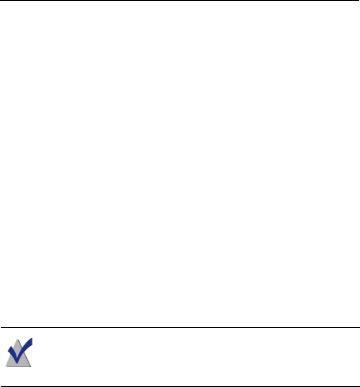
20Roxio Toast 11 User Guide www.roxio.com
5Record the disc. Select a recorder from the menu at the bottom of the Toast window if the one you are using is not already listed, and click the red record button.
Toast displays a progress bar and status information as it records your disc.
Tip: Choose Select Multiple Recorders at the bottom of the Toast window to burn your project to multiple discs at the same time.
Converting Video
Toast can convert video files to a variety of different formats — or even publish directly to popular video sharing sites.
To convert video:
1From the Toast Assistant, choose the Convert project category and select the Video Files project. If you're not using the Assistant, you can also do this from the main Toast window.
2Add video files to the project by dragging them into the Content Area from your hard disk or the Media Browser.
Note: You can add content from your high-definition (AVCHD) camcorder by clicking Video in the Media Browser and choosing AVCHD Camcorder.
3Click the red Convert button at the bottom right-hand corner of the screen.
4From the window that appears, choose the format and destination for your video. Some of the most commonly selected formats are listed in the following table:

Getting Started with Toast |
21 |
||
Converting Video |
|||
|
|||
|
|
|
|
Device Export Profiles
Apple TV |
Use this selection when exporting video for playback |
|
on Apple TV. Select iTunes as your destination to add |
|
your video directly to your iTunes library. |
iPad |
Use this selection when exporting video for playback |
|
on iPad. Select iTunes as your destination to add |
|
your video directly to your iTunes library. |
|
|
PlayStation 3 |
Use this selection when exporting video for playback |
|
on a PlayStation 3. To watch the video on the |
|
PlayStation 3 you can copy it to a USB flash drive, |
|
FAT32 formatted USB external hard disk, CD, or DVD. |
|
Some models also support video playback from |
|
Memory Stick, SD and Compact Flash cards. |
Xbox 360 |
Use this selection when exporting video for playback |
|
on an Xbox 360. To watch the video on the Xbox 360 |
|
you can copy it to a USB flash drive, FAT32 formatted |
|
USB external hard disk, CD, or DVD. |
|
|
YouTube |
This option converts and publishes video in your |
|
project to YouTube for sharing online. You are |
|
required to provide your YouTube account |
|
information, along with video category, description, |
|
and tags. |
Vimeo |
This option converts and publishes video in your |
|
project to Vimeo for sharing online. You are required |
|
to provide your Vimeo account information and a |
|
description of your video. |
|
|
This option converts and publishes video in your |
|
|
project to your Facebook profile for sharing online. |
|
When using this option you are required to provide |
|
your Facebook account information. |
|
|
Tip: Toast 11 now allows you to create custom video profiles. When exporting a video, select New Custom Profile at the bottom of the list,

22Roxio Toast 11 User Guide www.roxio.com
and you'll be able to create and manage your own custom export profiles.
Tip: Toast 11 includes VideoBoost technology to speed up H.264 video exports. For more information, see VideoBoost on page 132 or visit www.roxio.com/toast.
Getting Started with Toast |
23 |
||
Choosing the Right Project |
|||
|
|||
|
|
|
|
Choosing the Right Project
Toast can convert audio and video files and create discs in a wide variety of CD, DVD, and Blu-ray Disc formats.
Here are some of the most commonly used projects.
...I want to |
Use this disc format |
|
|
Back up general data files and folders, such as documents, photos and spreadsheets, to use at a later time only on a Mac.
Data > Mac Only. See Making a Mac Only Disc on page 47.
Back up general data files and folders |
Data > Mac & PC. See Making a Mac & |
to use at a later time on a Mac or a PC. |
PC Disc on page 53. |
|
|
Archive and share photos from my iPhoto library (or any other pictures) with friends and family.
Data > Photo Disc. See Making a Photo Disc on page 63.
Listen to music from my iTunes library |
Audio > Audio CD. See Making an |
in my home or car stereo CD player. |
Audio CD on page 70. |
|
|
Listen to music from my iTunes library in my DVD player.
Audio > Music DVD. See Making a Music DVD on page 75.
Watch slideshows and video on my |
Video > DVD-Video. See Making a |
TV. |
DVD or BD Video Disc on page 87. |
|
|
Make a DVD from an existing VIDEO_TS folder and compress it to fit on the disc.
Video > VIDEO_TS folders. See
Making a DVD From VIDEO_TS Folders on page 106.
Burn HD video to a standard DVD for |
Video > Blu-ray Video. See Making a |
playback on a Blu-ray Disc™ player. |
DVD or BD Video Disc on page 87. |
|
|
Copy a CD, DVD or Blu-ray disc to another disc.
Copy > Disc Copy. See Copying a Disc on page 119.
Create a high-definition Blu-ray video |
Video > Blu-ray Disc. See Making a |
disc for watching on a Blu-ray Disc™ |
DVD or BD Video Disc on page 87. |
player. |
|
|
|

24Roxio Toast 11 User Guide www.roxio.com
...I want to |
Use this disc format |
|
|
Publish home video to an online sharing service such as YouTube or Vimeo.
Convert > Video Files. See Converting Video Files on page 127.
Rip audiobook CDs into iTunes for |
Convert > Audiobook. See Converting |
listening on my Mac or iPod. |
Audiobooks on page 135. |
|
|
■For all data disc formats see Types of Data Discs on page 42.
■For all audio disc formats, see Types of Audio Discs on page 68.
■For all video disc formats, see Types of Video Discs on page 84.
■For all copy formats, see Types of Copies on page 118.
■For all convert formats, see Converting Media on page 123.
About Discs
Toast supports CD, DVD, and Blu-ray media types: CD, CD-RW, DVD-R/RW, DVD-R DL (dual-layer), DVD+R/RW, DVD+R DL (double-layer), DVD-RAM (cartridgeless), BD-R/RE, BD-R/RE DL (dual-layer). The type you should choose depends on the capabilities of your recorder and playback device, if applicable.
CD Media
If you have a CD recorder, you can use blank CD recordable (CD-R) media to create CDs. CDs typically hold 700 MB of information. Most CD recorders also support rewritable (CD-RW) media, which can be erased and reused. Although both CD-R and CD-RW media work well when creating discs for use on a computer, most home and car stereo players cannot recognize CD-RW media, so you should use CD-R when creating an audio CD.
DVD Media
If you have a DVD recorder, you can use blank DVD recordable (DVD-R or DVD+R) media to create DVDs. DVDs hold about 4.7 GB of information. Some DVD recorders support dual-layer recordable DVDs (DVD+R DL or DVD-R DL), which hold about 8.5 GB of information. Some DVD recorders also support rewritable (DVD-RW or DVD+RW) media, which can be erased and reused.
Getting Started with Toast |
25 |
||
About Discs |
|||
|
|||
|
|
|
|
Although all types work well when creating DVDs to use on a computer, most set-top DVD players can only recognize some types. You should check your DVD player documentation or search online to see which types the device supports.
Using low-cost generic media can cause errors while burning, or produce a disc that either is unrecognized by the player or plays back erratically. Different brands of the same type can work differently in your recorder or playback device. If you are having problems, you may need to switch to a different brand or type (for example, if using DVD-RW, switch to DVD-R).
Blu-ray Discs
If you have a Blu-ray recorder, you can use blank Blu-ray disc (BD-R) media to store data on Blu-ray discs which hold about 25 GB of information. Most Blu-ray recorders also support dual-layer Blu-ray discs, which hold about 50 GB of information. Some Blu-ray recorders also support rewritable (BDRE) media, which can be erased and reused.
Much like DVD players, some Blu-ray Disc set-top players may work better with one type of disc than another, and the same guidelines about switching to other brands or types apply here.

26Roxio Toast 11 User Guide www.roxio.com
Using the Media Browser
The Toast Media Browser provides quick access to your music, photos, videos, and other files stored on your computer. You can easily drag-and- drop content from the Media Browser into the Content Area.
To use the Media Browser:
1Show the Media Browser window by clicking the Media button or pressing Ctrl+S.
2Search for files or folders by entering a search term in the text field at the bottom of the Media Browser window, or choose the type of media you want to browse:
■Data: Browse files and folders on your local hard disk, external discs, or connected network volumes.
■Audio: Browse audio in your iTunes library.
■Video: Browse videos and iMovie projects in your Movies folder. You can also browse:
■Non-encrypted DVD-Video discs, mounted disc images, or VIDEO_TS folders located on your desktop or in your Movies folder.
■High-definition video content stored on your connected AVCHD camcorder or volume.
■Recorded TV shows from EyeTV. This option is only visible if you have EyeTV digital television recorder software installed (see www.elgato.com for more information).
■Recorded TV shows that have been transferred from your TiVo® DVR. This option requires a TiVo DVR that supports TiVoToGoTM transfers (see www.tivo.com for more information).
■Flash-based videos that have played in a web browser while Toast is open. Click Web Video to view thumbnails of all recorded videos.
■Photos: Browse photos in your iPhoto, Aperture, or Lightroom photo libraries.

Getting Started with Toast |
27 |
||
Using the Media Browser |
|||
|
|||
|
|
|
|
Note: You can also access discs from set-top DVD recorders or DVD camcorders. Toast includes special support for these discs, which normally are not usable in the Mac OS. Insert these discs in your recorder while Toast is running, and then import video from them with the Media Browser.
3To search for files or folders enter a search term in the text field at the bottom of the Media Browser window.
4When browsing audio, photos, movies, or DVDs, you can filter the media list by choosing a playlist, album, video or specific DVD, title or chapter from the Media Browser browse menu.
Note: You can expand the browse menu into a window by dragging down the small dot immediately below the menu.
5Select any item in the file list and drag it to the Content Area to add it to a disc project or click the Add button at the bottom of the Media Browser.
You can select multiple items by holding down the Command (Apple) key while clicking, and then drag the entire selection to the Content Area.
You can select groups of items by clicking on the first item in the group and then holding down the Shift key while clicking on the last item in the group, and then dragging the entire selection to the Content Area.
You can preview most media files by selecting them and pressing the space bar, by double-clicking them in the file list, or by clicking the Preview button at the bottom of the Media Browser.
Toast will display progress information while the items are being added. If the content is being added from a disc (such as from a set-top DVD recorder or AVCHD camcorder) this may take several minutes, as it is imported from the disc onto your hard disk.

28Roxio Toast 11 User Guide www.roxio.com
Imported items from a disc are temporarily stored in the Roxio Converted Items folder in your Documents folder. You can use these items in disc projects or save them to your hard disk by exporting audio or video. See Converting Media on page 123. These temporary items can be very large and are automatically deleted when you quit Toast. The original source content is not deleted from your disc.
Configuring when Roxio Converted Items is emptied
To adjust when the Roxio Converted Items is emptied:
1Choose Toast Titanium > Preferences.
2Click Storage.
3Choose when you want to delete the converted items.
4Close the preferences.
Changing Recorder Settings
You can view or change your recorder settings, such as which recorder to use for disc-based projects.
To change recorder settings:
1Click the Recording Options button at the bottom of Toast’s main window.
Tip: You can make this window appear each time you burn a disc by enabling Display Recorder Settings Before Writing on the Advanced tab of the Recorder Settings window.
2Click the Basic tab to change basic recording settings, including the selected recorder, write speed, and number of copies. (The Basic tab will be unavailable if you are using Multiple Recording burning.)
3Click the Advanced tab to change advanced recording settings, including:
■DAO/TAO: DAO (Disc-At-Once) audio recording allows pauses of varying lengths of up to 8 seconds between tracks. This option also allows for CD-TEXT. TAO (Track-At-Once) recording requires a pause of 2 seconds between all tracks.
Getting Started with Toast |
29 |
||
Changing Recorder Settings |
|||
|
|||
|
|
|
|
■Write Disc/Write Session: Select the session option if you are creating data CDs and wish to leave the disc “open” to add more data at a later time. See Making a Mac Only Disc on page 47.
■Enable Buffer Underrun Prevention: Select this option to turn on buffer underrun prevention. A buffer underrun error occurs when your hard disk is unable to send data fast enough to the recorder while recording, causing the blank disc to be unusable. This option is available only if your recorder supports buffer underrun prevention.
■Use Simulation Mode: Select this option if you want to simulate the process of recording a disc. You might do this to make sure that the write speed you have selected is appropriate for your computer.
■Verify Data: Select this option to verify that the contents of the recorded disc match the source files and folders on your hard disk.
■Catalog Disc Contents: Select to create a listing of all the files burned onto the disc.
■Display Recorder Settings Before Writing: Select this check box if you want to display the Recorder Settings dialog each time you click the red record button.
4Click the last tab to see information about the currently selected recorder.
5When you are finished, click OK.

30Roxio Toast 11 User Guide www.roxio.com
Saving and Opening Toast Projects
You can save a Toast project and open it at a later time for recording to disc.
To save the current project:
1Choose File > Save.
2Type a file name and select a location to save to.
3Click Save. Saved Toast disc projects end in “.disc".
To open a saved project:
1Choose File > Open.
2Select the Toast project file you want to open.
3Click Open.
Tip: You can browse to and quickly open the most recently used projects by choosing File > Open Recent, and clicking on a project. You can also double-click a Toast project to open it.
Note: Toast saves pointers for the files and folders in the content area. If you move or delete any of the original items from your hard disk, Toast may not be able to find them when you open the project. To save a single file containing all source files, you should save as a disc image. See Saving Disc Images on page 36.
